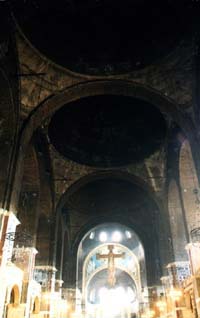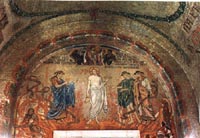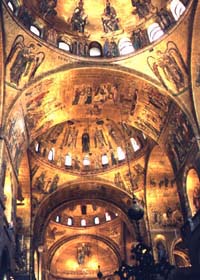If there's a billionaire out there willing to spend £25 million (c. $50 million) to immortalize his or her name, read on. There's a superb Heaven-storming project in the heart of London, England, which needs a sponsor.
THE CASE OF THE MISSING MOSAICS
 Thousands
attended the late great Cardinal Hume's requiem in Westminster Cathedral on June 25, 1999, and many thousands more watched on television. Doubtless
all were moved by the grand rite, the Mass as sacred opera, but those
who had never seen the actual building before must have been a little
puzzled by it. Why the lower half a temple and the upper half a railway
station? Why were the spectacular marble walls and pillars topped by a
ceiling of sooty brick and stained concrete? Did the money run out?
Thousands
attended the late great Cardinal Hume's requiem in Westminster Cathedral on June 25, 1999, and many thousands more watched on television. Doubtless
all were moved by the grand rite, the Mass as sacred opera, but those
who had never seen the actual building before must have been a little
puzzled by it. Why the lower half a temple and the upper half a railway
station? Why were the spectacular marble walls and pillars topped by a
ceiling of sooty brick and stained concrete? Did the money run out?
Well yes it did, and the ideas with it. When the church was built nobody in England really knew how to mosaic a church ceiling that vast.
But nowadays we do…
A century ago the then Archbishop of Westminster, Cardinal Vaughan, decreed a new Catholic cathedral for London. He and his architect John Bentley chose the Byzantine style partly so as not to compete with the Gothic glory of Westminster Abbey up the road, partly because it meant the basic edifice could be built fast, as cathedrals go. You didn't have to spend decades carving stone, you just laid bricks. The first went down in 1895, and eight years later the structure was complete, with the handsome exterior we see today.
The interior, on the other hand, was something else. It was left as brick and concrete, to be cladded by future generations in traditional Byzantine mode - marble below, mosaic above.
Today the marbling is finished, but most of the mosaic is missing. True, seven of the twelve chapels have their mosaics but almost the whole of the main ceiling remains bare. So the dominant impression as you enter the church is one of acres of sombre grime. Ten thousand square metres of gloom.
Some people like it; they positively relish the contrast between the polished polychrome marble and the rough darkness looming overhead. But the Byzantines would have had a fit: God is a God of Light. And murk is most definitely not what the architect wanted. He wanted mosaics.
In fact Bentley died before he could design a scheme for the main body of the building, and maybe that wasn't a bad thing. He'd got the architecture absolutely right - his cathedral is in effect a sister church to the Early Byzantine St. John at Ephesus - but didn't know how to mosaic it right. But then he didn't know any Byzantine mosaic artists; if he had, he would not have hung a thirty-foot cross high above the altar rails and impeded the view of the sanctuary ceiling. The great "rood" is a Western tradition, not a Byzantine one. He did know he wanted something like the mediaeval mosaics of St. Mark's in Venice - scenes from the life of Jesus and the saints - but wasn't sure how to go about it, how to draw up a suitable iconographic scheme. Real mosaicists were pretty rare birds in England at that time. So famous painters like John Singer Sargent and Alma-Tadema were invited to consider designing mosaics for individual chapels, by way of providing possible prototypes for the main area. (They declined.)
 Bentley
himself supervised and approved non-famous Christian Symons' designs for
the Holy Souls chapel. Symons' style however was pure Victorian Sentimental,
with nothing remotely Byzantine about it (see left). We conclude that
if Bentley had lived and the money had been forthcoming, the cathedral
would have been covered with Victorian figurative mosaics. Lots and lots
of them.
Bentley
himself supervised and approved non-famous Christian Symons' designs for
the Holy Souls chapel. Symons' style however was pure Victorian Sentimental,
with nothing remotely Byzantine about it (see left). We conclude that
if Bentley had lived and the money had been forthcoming, the cathedral
would have been covered with Victorian figurative mosaics. Lots and lots
of them.
Not necessarily a good idea. Even if you like the Victorian style. Because we have come to appreciate that what is magnificent about Bentley's building is the form above all, and if it were covered with hundreds of figures, in whatever style, the form would take second place. This is in fact what happened in St. Mark's: you see the mosaics first, and much later the architecture; the ceiling is too busy (see below). So one solution to Westminster would be to have non-figurative mosaics - a traditional Byzantine gold ground, say, enriched with crosses, other Christian symbols and abstract patterns. This is exactly what Justinian did in his St. Sophia in Constantinople, a fane even bigger than Westminster.
 If
you did decide to go for a slimmed-down figurative scheme, you would have
two major challenges. First, the iconography. Possibilities are infinite,
but one such might be to have each bay devoted to a major section of Christ's
life (Birth, Ministry, Passion, Resurrection), and dominating the whole
would be a Pantokrator, Christ the King, on the large east tympanum above
the sanctuary. (Bentley's crucifix would have to go, as would the existing
east tympanum mosaic.)
If
you did decide to go for a slimmed-down figurative scheme, you would have
two major challenges. First, the iconography. Possibilities are infinite,
but one such might be to have each bay devoted to a major section of Christ's
life (Birth, Ministry, Passion, Resurrection), and dominating the whole
would be a Pantokrator, Christ the King, on the large east tympanum above
the sanctuary. (Bentley's crucifix would have to go, as would the existing
east tympanum mosaic.)
Second, what style? In the completed chapels you find Victorian Sentimental, Victorian Gothic, Child's Illustrated Bible and Neo-Early-Byzantine. As the architecture of the cathedral interior is Neo-Early-Byzantine, that would seem the best choice for a figurative scheme, especially as Boris Anrep's Blessed Sacrament chapel (see below) in that style is generally held to be the most artistically successful of all the cathedral mosaics.
 Whatever
the choice, figurative or non-figurative, now is a good time to contemplate
completing Westminster Cathedral, because we are in the middle of a renaissance
of mosaic in this country. The art fell into disrepute in the sixties
when it became fashionable to clad buildings inside and out with what
amounted to mosaic wallpaper. A few dedicated artists kept true mosaic
alive, and then about ten years ago the thing began to grow, as a plethora
of books, magazine articles, tv programmes, and the newly-formed British
Association for Modern Mosaic testify. There are now perhaps two hundred
mosaic artists at work in Britain, some of them very experienced.
Whatever
the choice, figurative or non-figurative, now is a good time to contemplate
completing Westminster Cathedral, because we are in the middle of a renaissance
of mosaic in this country. The art fell into disrepute in the sixties
when it became fashionable to clad buildings inside and out with what
amounted to mosaic wallpaper. A few dedicated artists kept true mosaic
alive, and then about ten years ago the thing began to grow, as a plethora
of books, magazine articles, tv programmes, and the newly-formed British
Association for Modern Mosaic testify. There are now perhaps two hundred
mosaic artists at work in Britain, some of them very experienced.
Mosaicing Westminster would be a big job but not overwhelming. Once the artist was chosen and the design agreed, the mosaic would probably be made off-site, in sections, direct onto mesh. That would take two years or so; installing on site would take another six months. And yes, it would be possible to use computers to design the scheme down to the tiniest detail, if that's what the artist wanted. Sophisticated software exists which can do just that.
The cost? Byzantine-style mosaic, made from "smalti", small hand-cut pieces of opaque coloured glass, costs about £1200 per square metre: designed, made and installed. So 10,000 square metres would cost £12 million. More if a lot of gold were used.
Twelve million or so. To complete Westminster Cathedral. After a century of soot.
Now there's a Millennium project worthy of the name. There's a task for the next cardinal…
Paul Bentley
An edited version of this article appeared in the Daily Telegraph on Saturday, 24 July 1999. Since then the cost of smalti mosaic has gone up, so the cost would now be c. £30 million. It has also been suggested that the mosaics would best be done not off-site but by the direct method, in situ, the method the Byzantines used. This would take several years, but viewing platforms would mean that for a modest fee visitors could watch the mosaics being made and installed on the vaults and domes. It would be a wonderful opportunity for evangelization and no billionaire would be needed...
If you would like to know more about the Byzantine Empire click here
If you would like to look at my novel about the Fourth Crusade, the one which sacked Constantinople in 1204, click The Man Who Came After Hyacinth Bobo
Westminster Cathedral contact details :- The Administrator, Clergy House, 42 Francis Street, London SW1P 1QW, England
Three relevant links are:-
The Westminster
Cathedral website:- www.westminstercathedral.org.uk
The British Association for Modern Mosaic (BAMM) website:- www.bamm.org.uk
The Mosaic Matters website:- www.mosaicmatters.co.uk

